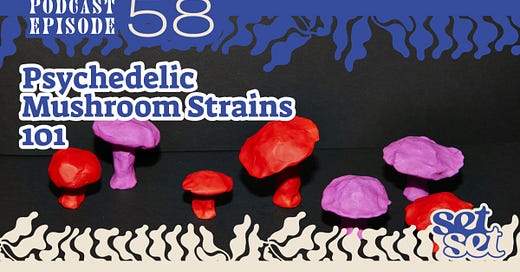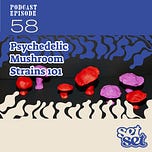What’s in a strain? More than you might think. In this foundational episode of The High Guide, April Pride unpacks the fuzzy—and fascinating—world of psilocybin mushroom strains. From the origin of the word “strain” to the real differences between varieties like Golden Teacher and Ecuador, this conversation sets the stage for the rest of the season. You’ll learn how mushroom genetics compare to cannabis and wine, what to look for on a dispensary menu, and why the term “strain” isn’t always the most accurate—but still sticks. Perfect for beginners and returning psychonauts alike, this episode empowers curious women with the language and lens to guide their next high.
🔵 Key Takeaways
Strain = Subtype: In both microbiology and cannabis, a “strain” refers to a genetically distinct version of a species—and psilocybin mushrooms follow suit.
Landrace = Ancestral: Most modern mushroom and cannabis strains descend from landrace genetics originating in places like Africa, Mexico, and Central America.
Variety vs. Strain: While “strain” is common in therapeutic and recreational use, “variety” is often used in scientific mycology. Both refer to differences in appearance, potency, and effect.
Know Your Intentions: Some mushroom varieties are better suited for introspection, while others may support creativity or emotional release.
Coming Soon: Each episode this season will spotlight one specific strain—its origin, use case, effects, and trip tips.
🔵 Timestamps
[00:19] Introducing the show and theme: psilocybin mushroom strains
[00:45] Word of the Week: Strain, defined in science and cannabis
[01:32] What terroir tells us about strain variation
[02:12] A quick history of cannabis genetics
[02:35] The shift from CBD-rich to THC-dominant strains
[03:33] Indica vs. sativa: plant structure and adaptation
[04:14] Are “strains” the right word for psilocybin mushrooms?
[05:09] Why terminology is tricky: strain vs. variety vs. morphotype
[06:16] What to expect in this season’s shroom strain spotlights
🔵 Additional Resources
SetSet Blog: “Psychedelic Integration for Women”
SetSet Blog: “The Science and Safety of Microdosing Mushrooms for Women”
🎙️SetSet Podcast: “How to Identify Psychedelic Mushrooms”
🎙️SetSet Podcast: “Psilocybin Mushrooms 101: Effects, Dosing & Tips”
🎙️SetSet Podcast: “Psilocybin Mushroom Dosage: A Beginner’s Guide”
How do you choose a psilocybin strain? What’s worked for you—or what still feels confusing? 👇 Let’s talk about it in the comments after the transcript below.
🔵 Transcript
[00:00] April Pride:
All modern [psilocybin mushroom strains] derive from landrace strains. Think of these as ancestral strains. These are strains that come from throughout the world—Jamaica, India, Africa, Mexico, Pakistan, Afghanistan, and Central America.
[00:19] April Pride:
I'm April Pride, your host on The High Guide podcast. This is the show for women who have an open and curious mind, and this is a show all about women changing their lives thanks to altered states of consciousness. At the top of this show, you heard from me—audio from a previous episode about strains—which is what we're gonna get into today in the context of [psilocybin mushroom strains]. Or am I correct in using this weed word for the fungi? Listen on to find out. Up next is our word of the week, and stay tuned to the almost end for our trip tips.
[00:45] April Pride:
And now for the word of the week, strain. In microbiology, a strain is a subpopulation of species that differs in some way from other subpopulations of the same species. These differences can include distinct physical, chemical, or psychoactive properties. This difference could be due to genetic or environmental factors and can result in variations in characteristics such as growth rate, antibiotic resistance, or biochemical properties. These differences can also result in different effects when consumed. Let's explore the word strain in the context of cannabis, which boasts over 700 strains. Most of these strains are from hybrid variations of a limited number of original landrace strains that were documented throughout the world. Listen on as I nerd out on strains in an earlier episode.
[01:32] April Pride:
If you're a wine lover, you know about terroir, a French term used to describe the complete natural environment in which a particular wine is produced. And just like wine and food, terroir is also critical to weed. The elements—soil, light, climate—all influence its original genetics. Nature, nurture, right? Variations in growing conditions can produce two very different cultivars or cultivated varieties of a single strain. So the Blue Dream from one grow may look, smell, and make you feel different than a Blue Dream from another grow with different terroir, like state to state.
[02:12] April Pride:
So cannabis plant genetics. There are thousands of cannabis strains available, and new ones bred on a regular basis. Some quick history about strains. All modern cannabis genetics derived from landrace strains—think of these as ancestral strains. These are strains that come from throughout the world—Jamaica, India, Africa, Mexico, Pakistan, Afghanistan, and Central America.
[02:35] April Pride:
Landrace strains with low THC and higher in CBD were more therapeutic and less intoxicating. And this was the genetic profile of the cannabis used in Chinese medicine and by pharmacists in the U.S. who used cannabis in 150 prescription formulations and compounds before prohibition was enacted in the early 20th century. The strains you can buy today all derive from landrace strains, and we call them heirloom strains. What makes them different? The original genetics of landrace strains have been modified through crossbreeding to make the plants adapt to modern cultivation needs—for instance, shorter growth cycles and more resistance to bugs and disease. They were also bred with a singular intention of getting people higher—a lot higher. In the 20th century, nearly all of the CBD was bred out while simultaneously levels of THC—the stuff that gets you high—increased wildly, like from 6% to 26%.
[03:33] April Pride:
You might be familiar with terms like sativa, indica, or hybrid. All heirloom strains are technically hybrids. Indica and sativa describe two distinct types of cannabis plants—specifically plant structures—that evolved because of where they were grown and how they adapted to conditions within that natural environment. Generally speaking, sativa strains grew naturally in areas that were closer to the equator and adapted to thrive in this hot climate with little water. Indica strains historically grew in more temperate, mountainous areas, and these plants adapted to survive the colder winters of their natural habitat.
[04:14] April Pride:
Yes, the different types of [psilocybin mushroom strains] are commonly referred to as strains. Each strain typically has its own characteristics, such as appearance, potency, and effects. Also, the different types of [psychedelic fungi varieties] can be referred to as varieties. In the context of mycology, the study of fungi, the term variety is often used to describe different subtypes or variations within a given species. For example, psilocybe cubensis is a species of psychedelic mushrooms, but within that species there are different varieties, such as Golden Teacher and Ecuador, which you'll learn about this season, and which have different physical and chemical characteristics. So while strain is a more commonly used term in the recreational or therapeutic use of psilocybin mushrooms, variety is also a valid way to refer to different types of these mushrooms from a mycological perspective.
[05:09] April Pride:
Going back to the word of the week definition—in microbiology, a strain is a subpopulation of a species that differs in some way from other subpopulations of the same species. Check. These differences can include distinct physical, chemical or psychoactive properties. Check. The difference could be due to genetic or environmental factors and can result in variations in characteristics such as growth rate, antibiotic resistance, or biochemical properties. Check. These differences can also result in different effects when consumed. Check. So if [psilocybin mushroom strains] are often used to describe different subtypes of the same species, such as psilocybe cubensis, then why in the field of mycology is there an ongoing debate about the appropriate use of the term strain versus other terms like variety or morphotype to describe different subpopulations of fungi? The terminology can vary depending on the specific species or context, making the language somewhat loose and inconsistent. So it's always important to understand the precise meaning intended by the person using the term. Even Darwin struggled with hair-splitting. He said, "I was much struck how entirely vague and arbitrary the distinction between species and varieties."
[06:16] April Pride:
Choosing the right [psilocybin mushroom strain] shouldn't be overwhelming, but as access opens up, no doubt, you'll be curious about the names on menus. So please use this series as your reference. Use these episodes to guide your high. Intended to be snack-sized, each episode is dedicated to one. I mean—how can I not call it a [shroom strain]? [chuckle] It rolls off the tongue and by definition as we've covered. So we'll do a deep dive covering the following information for a single type of [psychedelic fungi variety]: the species and origin, their appearance, the intention that a lot of people use a specific variety or [shroom strain] for, potency, effects, and duration.
[06:54] April Pride:
And of course, we end each episode with trip tips. If you're picking up what we're putting down, send us a DM and let us know how the strain worked for you. Or if you think the strain we're describing is perfect for a friend or relative, screenshot the episode and shoot it over to them in a text or save it for the next time you're in the mood for magic.
[07:14] April Pride:
Thank you for listening to this episode of The High Guide. I'm your host, April Pride. Please check out our website, thehigh.guide, for our [shroom strain] reviews and guide to [psilocybin]. Tune in next Friday for another episode of The High Guide—a show all about women changing their lives thanks to altered states of consciousness.














Share this post